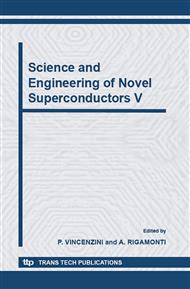p.88
p.93
p.98
p.104
p.108
p.113
p.118
p.124
p.131
Effect of Co Doping on the Superconducting Properties of Overdoped (Lu0.8Ca0.2)Ba2Cu3Oz
Abstract:
The effect of Co-doping and thermal treatments on the superconducting properties of the heavily overdoped (Lu0.8Ca0.2)Ba2Cu3Oz has been investigated by X-ray diffraction, resistivity and thermoelectric power measurements. A comparative analysis of the resistivity and thermoelectric power of the (Lu0.8Ca0.2)Ba2(Cu3-xCox)Oz and the heat-treated Co-free (Lu0.8Ca0.2)Ba2Cu3Oz reveals that, in the overdoped region, the hole carriers reduced by the Co doping and by the oxygen depletion play a very similar role in the superconducting properties. As a result, a nearly common inverted parabolic correlation is observed between Tc and the planar carrier concentration determined from the room-temperature thermoelectric power measurements.
Info:
Periodical:
Pages:
108-112
Citation:
Online since:
October 2006
Authors:
Price:
Сopyright:
© 2006 Trans Tech Publications Ltd. All Rights Reserved
Share:
Citation:


